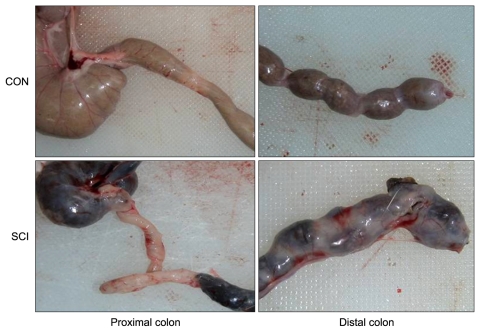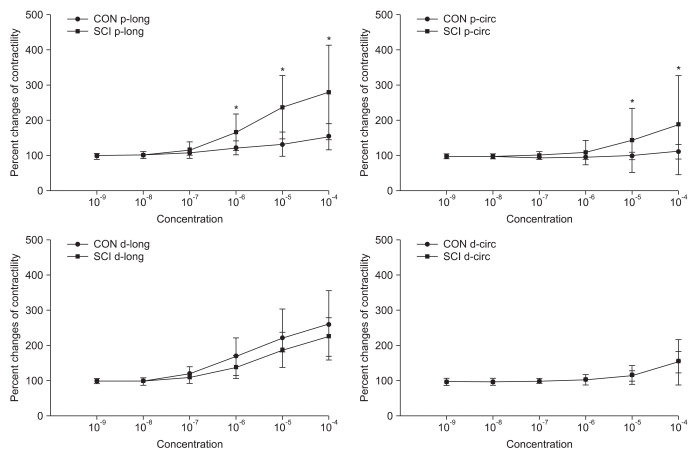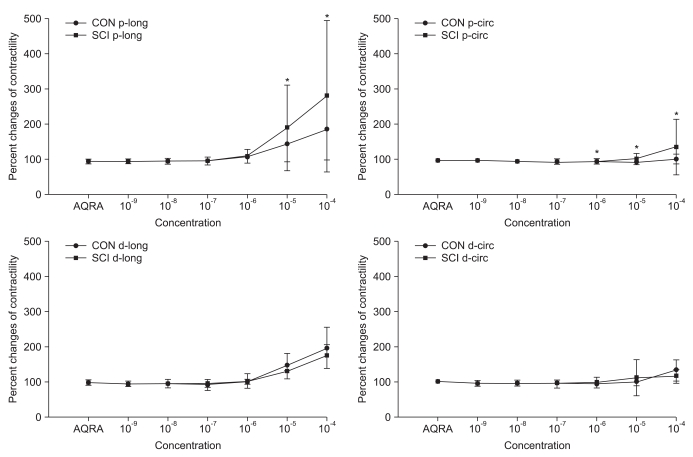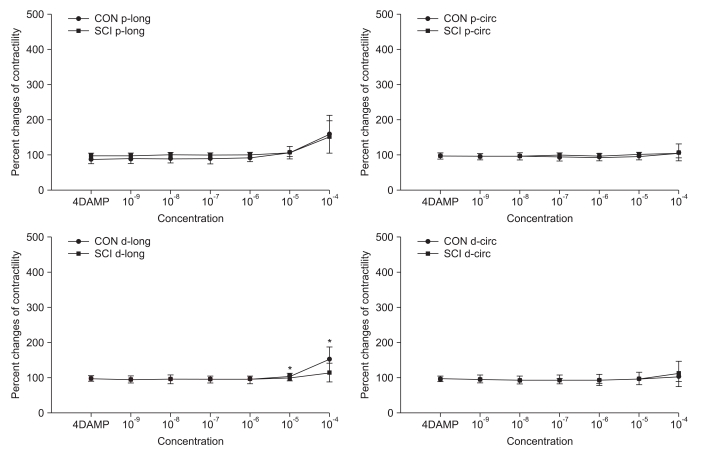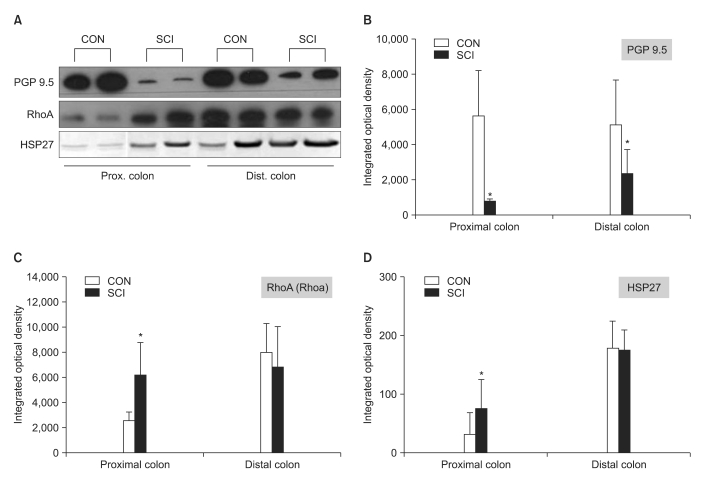Ann Rehabil Med.
2011 Oct;35(5):589-598. 10.5535/arm.2011.35.5.589.
Changes in the Muscarinic Receptors on the Colonic Smooth Muscles of Rats with Spinal Cord Injury
- Affiliations
-
- 1Department of Rehabilitation Medicine and Institute of Wonkwang Medical Science, Wonkwang University School of Medicine, Iksan 570-749, Korea.
- 2Department of Internal Medicine and Digestive Disease Research Institute, Wonkwang University School of Medicine, Iksan 570-749, Korea.
- 3Department of Physiology, Wonkwang University School of Medicine, Iksan 570-749, Korea. lym6774@wku.ac.kr
- 4Department of Surgery, Wonkwang University School of Medicine, Iksan 570-749, Korea.
- KMID: 2267219
- DOI: http://doi.org/10.5535/arm.2011.35.5.589
Abstract
OBJECTIVE
To investigate changes in (1) the colonic response to acetylcholine (Ach), (2) the muscarinic (M) receptors in the colon, and (3) the levels of colonic contraction-related proteins after a spinal cord injury (SCI). METHOD: We divided 16 Sprague-Dawley rats into 2 groups: the control group and the SCI group. A spinal cord transection was performed surgically at the T10 vertebral level. After 1 week, the entire colon was divided into 2 segments, the proximal and distal colon. Each segment was mounted in a longitudinal or circular muscle direction in a 10-ml organ bath. We determined the intergroup differences as percentage changes in contractility after Ach treatment alone, Ach treatment with M2 receptor antagonist (AQ-RA741) pretreatment, and Ach treatment with M3 receptor antagonist (4-DAMP) pretreatment. Western blot analyses were performed to determine the expression level of RhoA, and heat shock protein 27 (HSP27).
RESULTS
Compared to the control rats, the SCI rats showed an increased response to Ach along both the directions in the proximal colon (p<0.05). Compared to the control group, in the SCI group, the Ach response was significantly different in the proximal segment under AQ-RA741 pretreatment (p<0.05) and in the distal segment under 4-DAMP pretreatment (p<0.05). Findings of the western blot analyses showed a significant decrease in the level of protein gene product 9.5 in the proximal and distal colon and a significant increase in the level of RhoA and HSP27 in the proximal colon of the SCI rats.
CONCLUSION
Our results suggest that changes in colonic contractility after SCI are partly attributable to changes in the M receptor subtypes.
Keyword
MeSH Terms
Figure
Reference
-
1. Glickman S, Kamm MA. Bowel dysfunction in spinalcord-injury patients. Lancet. 1996; 347:1651–1653. PMID: 8642958.
Article2. Longo WE, Ballantyne GH, Modlin IM. The colon, anorectum and spinal cord patient. A review of the functional alterations of the denervated hindgut. Dis Colon Rectum. 1989; 32:261–267. PMID: 2646085.3. Menardo G, Bausano G, Corazziari E, Fazio A, Marangi A, Genta V, Marenco G. Large-bowel transit in paraplegic patients. Dis Colon Rectum. 1987; 30:924–928. PMID: 3691262.
Article4. Im SH, Rah UW, Lee IY, Cho KH. Colon transit time and management of upper motor neuron type neurogenic bowel in spinal cord injury. J Korean Acad Rehabil Med. 2000; 24:446–452.5. Beuret-Blanquart F, Weber J, Gouvemeur JP, Demangeon S, Denis P. Colon transit time and anorectal manometric anomalies in 19 patients with complete transection of the spinal cord. J Auton Nerv Syst. 1990; 30:199–207. PMID: 2229888.6. Zhang LB, Horowitz B, Buxton IL. Muscarinic receptors in canine colonic circular smooth muscle. I. Coexistence of M2 and M3 subtypes. Mol Pharmacol. 1991; 40:943–951. PMID: 1758444.7. Uchiyama T, Chess-Williams R. Muscarinic receptor subtypes of the bladder and gastrointestinal tract. J Smooth Muscle Res. 2004; 40:237–247. PMID: 15725706.
Article8. Tong YC, Chin WT, Cheng JT. Alterations in urinary bladder M2-muscarinic receptor protein and mRNA in 2-week streptozotocin-induced diabetic rats. Neurosci Lett. 1999; 277:173–176. PMID: 10626841.
Article9. Braverman AS, Ruggieri MR Sr. Hypertrophy changes the muscarinic receptor subtype mediating bladder contraction from M3 toward M2. Am J Physiol Regul Integr Comp Physiol. 2003; 285:R701–R708. PMID: 12763741.10. Meshkinpour H, Harmon D, Thompson R, Yu J. Effects of thoracic spinal cord transection on colonic motor activity in rats. Paraplegia. 1985; 23:272–276. PMID: 4069737.
Article11. Fajardo NR, Pasiliao RV, Modeste-Duncan R, Creasey G, Bauman WA, Korsten MA. Decreased colonic motility in persons with chronic spinal cord injury. Am J Gastroenterol. 2003; 98:128–134. PMID: 12526948.
Article12. Lim SS, Choi KH, Myung SJ, Sung IY. Evaluation of the neurogenic bowel by colon transit time and anorectal manometry in the spinal cord injured patients. J Korean Acad Rehabil Med. 2001; 25:249–255.13. Gómez A, Martos F, Bellido I, Marquez E, Garcia AJ, Pavia J, Cuesta FS. Muscarinic receptor subtypes in human and rat colon smooth muscle. Biochem Pharmacol. 1992; 43:2413–2419. PMID: 1610405.
Article14. Kerr PM, Hillier K, Wallis RM, Garland CJ. Charactrization of muscarinic receptors mediating contractions of circular and longitudinal muscle of human isolated colon. Br J Pharmacol. 1995; 115:1518–1524. PMID: 8564213.15. Matsui M, Motomura D, Fujikawa T, Jiang J, Takahashi S, Manabe T, Taketo MM. Mice lacking M2 and M3 muscarinic acetylcholine receptors are devoid of cholinergic smooth muscle contractions but still viable. J Neurosci. 2002; 22:10627–10632. PMID: 12486155.16. Matsui M, Motomura D, Karasawa H, Fujikawa T, Jiang J, Komiya Y, Takahashi S, Taketo MM. Multiple functional defects in peripheral autonomic organs in mice lacking muscarinic acetylcholine receptor gene for the M3 subtype. Proc Natl Acad Sci USA. 2000; 97:9579–9584. PMID: 10944224.
Article17. Yamboliev IA, Hedges JC, Mutnick JL, Adam LP, Gerthoffer WT. Evidence for modulation of smooth muscle force by the p38 MAP kinase/HSP27 pathway. Am J Physiol Heart Circ Physiol. 2000; 278:H1899–H1907. PMID: 10843887.18. Somara S, Bitar KN. Phosphorylated HSP27 modulates the association of phosphorylated caldesmon with tropomyosin in colonic smooth muscle. Am J Physiol Gastrointest Liver Physiol. 2006; 291:G630–G639. PMID: 16627824.
Article19. Patil SB, Tsunoda Y, Pawar MD, Bitar KN. Translocation and association of ROCK-II with RhoA and HSP27 during contraction of rabbit colon smooth muscle cells. Biochem Biophys Res Commun. 2004; 319:95–102. PMID: 15158447.
Article20. Patil SB, Pawar MD, Bitar KN. Phosphorylated HSP27 essential for acetylcholine-induced association of RhoA with PKCalpha. Am J Physiol Gastrointest Liver Physiol. 2004; 286:G635–G644. PMID: 14592945.21. Kent C, Clarke PJ. The immunolocalisation of the neuro endocrine specific protein PGP9.5 during neurogenesis in the rat. Dev Brain Res. 1991; 58:147–150. PMID: 1826643.22. Matsumoto K, Hosoya T, Tashima K, Namiki T, Murayama T, Horie S. Distribution of transient receptor potential vanilloid 1 channel-expressing nerve fibers in mouse rectal and colonic enteric nervous system: relationship to peptidergic and nitrergic neurons. Neuroscience. 2011; 172:518–534. PMID: 20951772.
Article23. Brady CM, Apostolidis AN, Harper M, Yiangou Y, Becjett A, Jacques TS, Freeman A, Scaravilli F, Fowler CJ, Anand P. Paraller changes in bladder suburothelial vanilloid receptor TRPV1 and pan-neural marker PGP9.5 immunoreactivity in patients with neurogenic detrusor overactivity after intravesical resiniferatoxin treatment. BJU Int. 2004; 93:770–776. PMID: 15049988.
- Full Text Links
- Actions
-
Cited
- CITED
-
- Close
- Share
- Similar articles
-
- Distribution of the muscarinic receptors and characterization in the brain of wistar rats and spontaneously hypertensive rats(SHR strain) by digital autoradiography
- Additive interaction of intrathecal ginsenosides and neostigmine in the rat formalin test
- Muscarinic Receptors Distributed in the Lower Urinary Tract
- Effect of Spinal Adrenergic and Cholinergic Antagonists for Antinociception of Intrathecal Gabapentin
- The role of spinal adrenergic receptors on the antinociception of ginsenosides in a rat postoperative pain model

